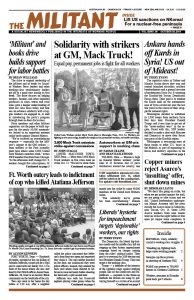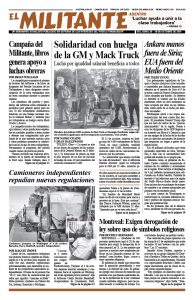October 31, 1994
LOS ANGELES — Seventy thousand people marched through the streets here October 16 to protest Proposition 187, an anti-immigrant measure on the November ballot. The large turnout — it was the biggest such action in years — dealt a blow to the ongoing campaign by capitalist politicians and rightist forces in California to intimidate immigrant workers.
The legislative proposal would deny the right to public education, health care, and social services to undocumented workers and their children.
The great majority of marchers were Latino. For the first time in recent immigrant rights actions, there was a significant number of unionists marching.
The coalition is proceeding on the basis that whatever the outcome of the vote on 187, the immigrant-bashing drive will continue and the fight against it will also continue.
October 31, 1969
While the Shah of Iran was lunching at New York’s luxurious Waldorf-Astoria Hotel Oct. 18, students were peacefully protesting this brutal dictator’s state visit to the government that put him in power via a 1953 CIA-inspired coup. Uniformed and plainclothes police brutally attacked the demonstration, arresting three Iranians, one American and beating several others.
Sponsored by the Iranian Students Association, the picket line was supported by the Young Socialist Alliance, Youth Against War and Fascism and the Organization of Arab Students.
The demonstration had been called to draw attention to the brutal repression in Iran, which has resulted in the execution, imprisonment and torture of hundreds of dissidents, including students, religious leaders, and the Kurdish minority that has taken to armed struggle against the repression.
October 28, 1944
Before, during and after the war, the all-absorbing interest of the corporation owners is profits. The automotive moguls are pressing for a policy of low output and high prices. According to the CIO United Automobile Workers’ reports, the auto industry is insisting on price increases for new cars from 25 to 40 per cent.
They are prepared to produce 6,700,000 cars a year — with 40 per cent less workers than now employed. This is an admission that labour productivity, the amount of production per man-hour of work, has increased 26 per cent during the war, without a corresponding increase in hourly wage rates.
General Motors, for instance, which is spearheading the drive for higher prices, lower wages and reduced employment, increased its cash assets alone since 1939 from $155,000,000 to $287,000,000.

